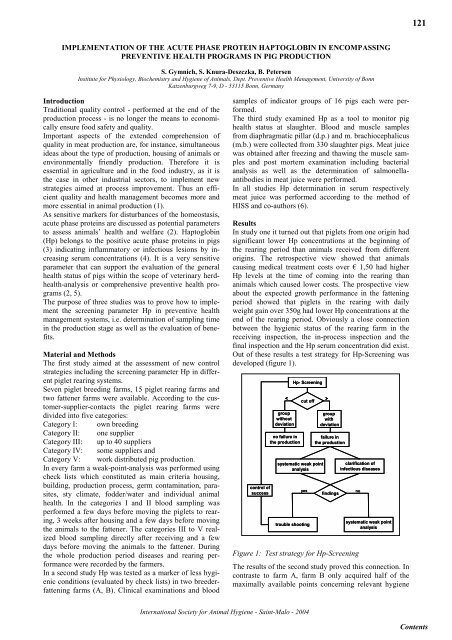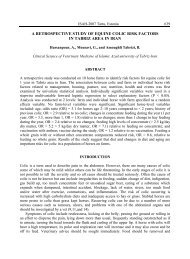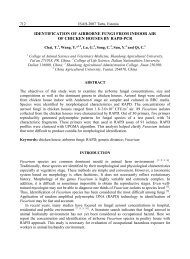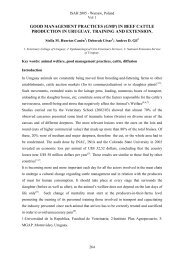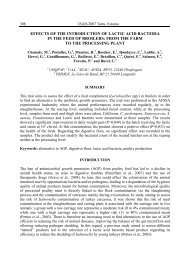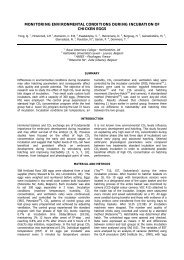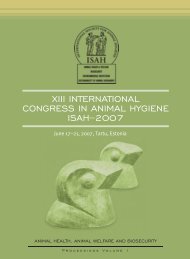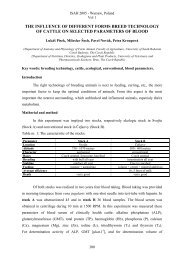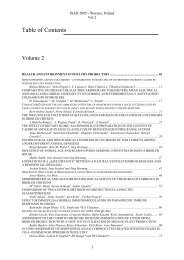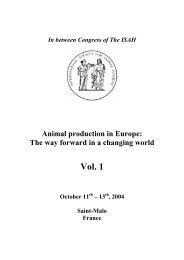implementation of the acute phase protein haptoglobin ... - ISAH-SOC
implementation of the acute phase protein haptoglobin ... - ISAH-SOC
implementation of the acute phase protein haptoglobin ... - ISAH-SOC
You also want an ePaper? Increase the reach of your titles
YUMPU automatically turns print PDFs into web optimized ePapers that Google loves.
121<br />
IMPLEMENTATION OF THE ACUTE PHASE PROTEIN HAPTOGLOBIN IN ENCOMPASSING<br />
PREVENTIVE HEALTH PROGRAMS IN PIG PRODUCTION<br />
S. Gymnich, S. Knura-Deszczka, B. Petersen<br />
Institute for Physiology, Biochemistry and Hygiene <strong>of</strong> Animals, Dept. Preventive Health Management, University <strong>of</strong> Bonn<br />
Katzenburgweg 7-9, D - 53115 Bonn, Germany<br />
Introduction<br />
Traditional quality control - performed at <strong>the</strong> end <strong>of</strong> <strong>the</strong><br />
production process - is no longer <strong>the</strong> means to economically<br />
ensure food safety and quality.<br />
Important aspects <strong>of</strong> <strong>the</strong> extended comprehension <strong>of</strong><br />
quality in meat production are, for instance, simultaneous<br />
ideas about <strong>the</strong> type <strong>of</strong> production, housing <strong>of</strong> animals or<br />
environmentally friendly production. Therefore it is<br />
essential in agriculture and in <strong>the</strong> food industry, as it is<br />
<strong>the</strong> case in o<strong>the</strong>r industrial sectors, to implement new<br />
strategies aimed at process improvement. Thus an efficient<br />
quality and health management becomes more and<br />
more essential in animal production (1).<br />
As sensitive markers for disturbances <strong>of</strong> <strong>the</strong> homeostasis,<br />
<strong>acute</strong> <strong>phase</strong> <strong>protein</strong>s are discussed as potential parameters<br />
to assess animals’ health and welfare (2). Haptoglobin<br />
(Hp) belongs to <strong>the</strong> positive <strong>acute</strong> <strong>phase</strong> <strong>protein</strong>s in pigs<br />
(3) indicating inflammatory or infectious lesions by increasing<br />
serum concentrations (4). It is a very sensitive<br />
parameter that can support <strong>the</strong> evaluation <strong>of</strong> <strong>the</strong> general<br />
health status <strong>of</strong> pigs within <strong>the</strong> scope <strong>of</strong> veterinary herdhealth-analysis<br />
or comprehensive preventive health programs<br />
(2, 5).<br />
The purpose <strong>of</strong> three studies was to prove how to implement<br />
<strong>the</strong> screening parameter Hp in preventive health<br />
management systems, i.e. determination <strong>of</strong> sampling time<br />
in <strong>the</strong> production stage as well as <strong>the</strong> evaluation <strong>of</strong> benefits.<br />
Material and Methods<br />
The first study aimed at <strong>the</strong> assessment <strong>of</strong> new control<br />
strategies including <strong>the</strong> screening parameter Hp in different<br />
piglet rearing systems.<br />
Seven piglet breeding farms, 15 piglet rearing farms and<br />
two fattener farms were available. According to <strong>the</strong> customer-supplier-contacts<br />
<strong>the</strong> piglet rearing farms were<br />
divided into five categories:<br />
Category I: own breeding<br />
Category II: one supplier<br />
Category III: up to 40 suppliers<br />
Category IV: some suppliers and<br />
Category V: work distributed pig production.<br />
In every farm a weak-point-analysis was performed using<br />
check lists which constituted as main criteria housing,<br />
building, production process, germ contamination, parasites,<br />
sty climate, fodder/water and individual animal<br />
health. In <strong>the</strong> categories I and II blood sampling was<br />
performed a few days before moving <strong>the</strong> piglets to rearing,<br />
3 weeks after housing and a few days before moving<br />
<strong>the</strong> animals to <strong>the</strong> fattener. The categories III to V realized<br />
blood sampling directly after receiving and a few<br />
days before moving <strong>the</strong> animals to <strong>the</strong> fattener. During<br />
<strong>the</strong> whole production period diseases and rearing performance<br />
were recorded by <strong>the</strong> farmers.<br />
In a second study Hp was tested as a marker <strong>of</strong> less hygienic<br />
conditions (evaluated by check lists) in two breederfattening<br />
farms (A, B). Clinical examinations and blood<br />
samples <strong>of</strong> indicator groups <strong>of</strong> 16 pigs each were performed.<br />
The third study examined Hp as a tool to monitor pig<br />
health status at slaughter. Blood and muscle samples<br />
from diaphragmatic pillar (d.p.) and m. brachiocephalicus<br />
(m.b.) were collected from 330 slaughter pigs. Meat juice<br />
was obtained after freezing and thawing <strong>the</strong> muscle samples<br />
and post mortem examination including bacterial<br />
analysis as well as <strong>the</strong> determination <strong>of</strong> salmonellaantibodies<br />
in meat juice were performed.<br />
In all studies Hp determination in serum respectively<br />
meat juice was performed according to <strong>the</strong> method <strong>of</strong><br />
HISS and co-authors (6).<br />
Results<br />
In study one it turned out that piglets from one origin had<br />
significant lower Hp concentrations at <strong>the</strong> beginning <strong>of</strong><br />
<strong>the</strong> rearing period than animals received from different<br />
origins. The retrospective view showed that animals<br />
causing medical treatment costs over € 1,50 had higher<br />
Hp levels at <strong>the</strong> time <strong>of</strong> coming into <strong>the</strong> rearing than<br />
animals which caused lower costs. The prospective view<br />
about <strong>the</strong> expected growth performance in <strong>the</strong> fattening<br />
period showed that piglets in <strong>the</strong> rearing with daily<br />
weight gain over 350g had lower Hp concentrations at <strong>the</strong><br />
end <strong>of</strong> <strong>the</strong> rearing period. Obviously a close connection<br />
between <strong>the</strong> hygienic status <strong>of</strong> <strong>the</strong> rearing farm in <strong>the</strong><br />
receiving inspection, <strong>the</strong> in-process inspection and <strong>the</strong><br />
final inspection and <strong>the</strong> Hp serum concentration did exist.<br />
Out <strong>of</strong> <strong>the</strong>se results a test strategy for Hp-Screening was<br />
developed (figure 1).<br />
control <strong>of</strong><br />
success<br />
< ><br />
cut <strong>of</strong>f<br />
group<br />
without<br />
deviation<br />
no failure in<br />
<strong>the</strong> production<br />
Hp- Screening<br />
systematic weak point<br />
analysis<br />
yes<br />
trouble shooting<br />
group<br />
with<br />
deviation<br />
failure in<br />
<strong>the</strong> production<br />
findings<br />
clarification <strong>of</strong><br />
infectious diseases<br />
Figure 1: Test strategy for Hp-Screening<br />
The results <strong>of</strong> <strong>the</strong> second study proved this connection. In<br />
contraste to farm A, farm B only acquired half <strong>of</strong> <strong>the</strong><br />
maximally available points concerning relevant hygiene<br />
no<br />
systematic weak point<br />
analysis<br />
International Society for Animal Hygiène - Saint-Malo - 2004 141<br />
Contents 145
122<br />
factors and was <strong>the</strong>refore rated „unsufficient“. The pigs<br />
<strong>of</strong> farm B showed more <strong>of</strong>ten clinical symptoms than<br />
those <strong>of</strong> farm A which was reflected by comparing <strong>the</strong><br />
time course <strong>of</strong> growth <strong>of</strong> <strong>the</strong> two fattening groups. The<br />
performance <strong>of</strong> pigs in farm A followed <strong>the</strong> normally<br />
observed physiological course <strong>of</strong> growth while <strong>the</strong><br />
growth <strong>of</strong> pigs in farm B was depressed (figure 2). It was<br />
conspicuous that <strong>the</strong>re were also statistically significant<br />
differences in Hp concentration between animals showing<br />
no observable clinical deficits from farm B in comparison<br />
to pigs from farm A.<br />
average daily weight gain (g)<br />
1100<br />
1000<br />
900<br />
800<br />
700<br />
600<br />
500<br />
400<br />
300<br />
200<br />
100<br />
0<br />
0<br />
20<br />
40<br />
60<br />
80<br />
liveweight (kg)<br />
Figure 2: Physiological cost <strong>of</strong> growth and average daily<br />
weight gain <strong>of</strong> pigs in farm A and B<br />
In <strong>the</strong> third study Hp concentrations in blood could be<br />
correlated significantly (p


